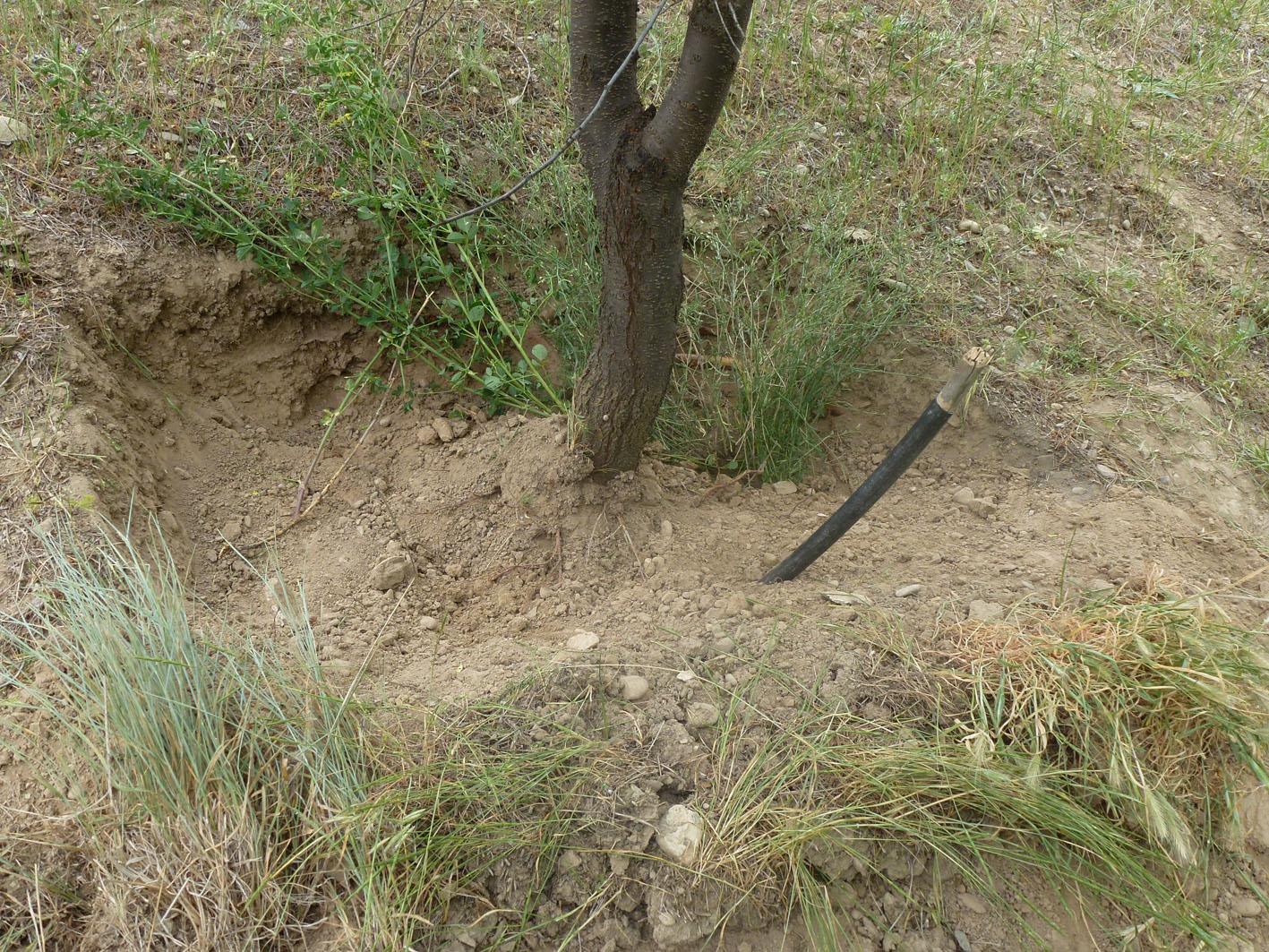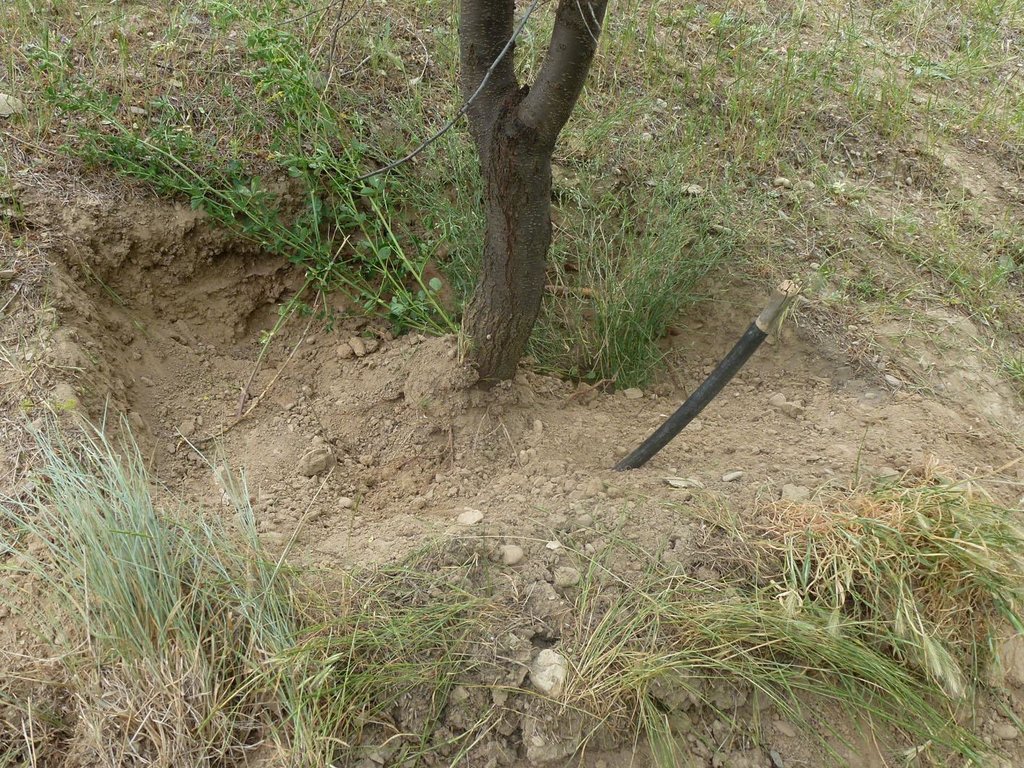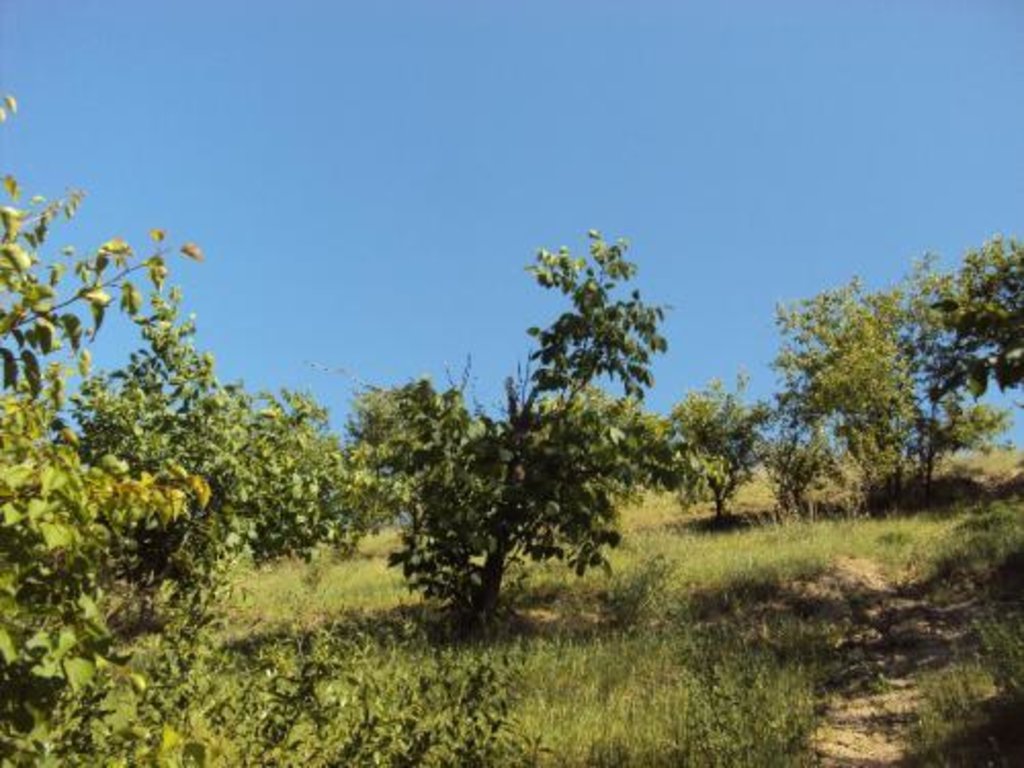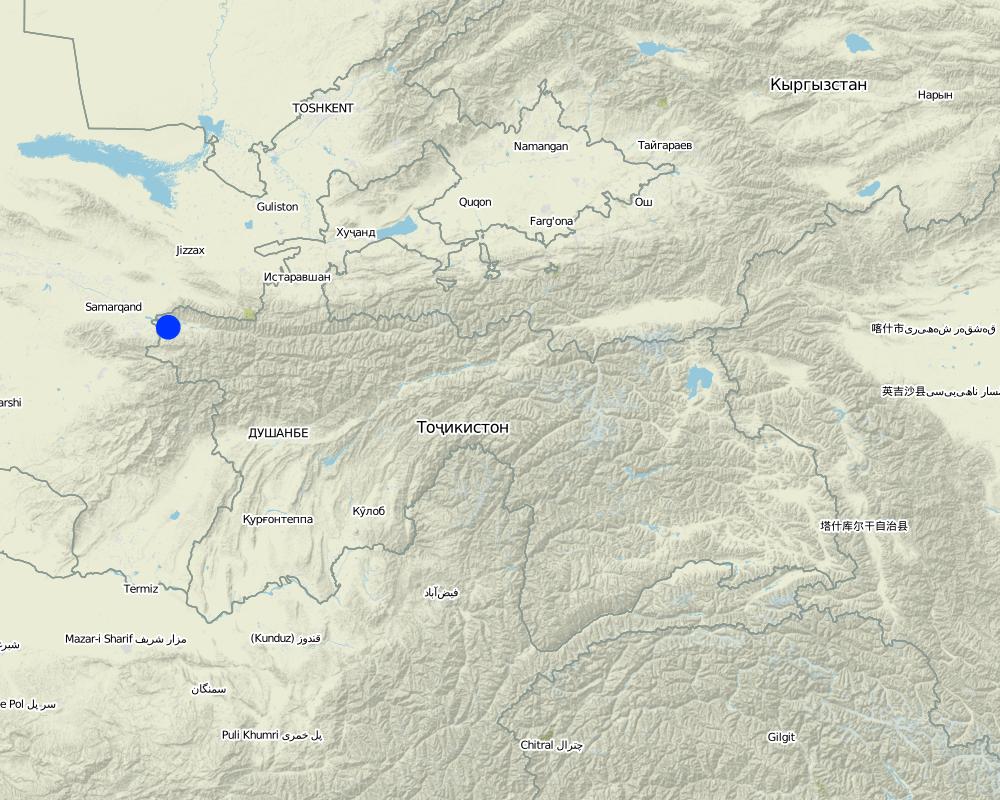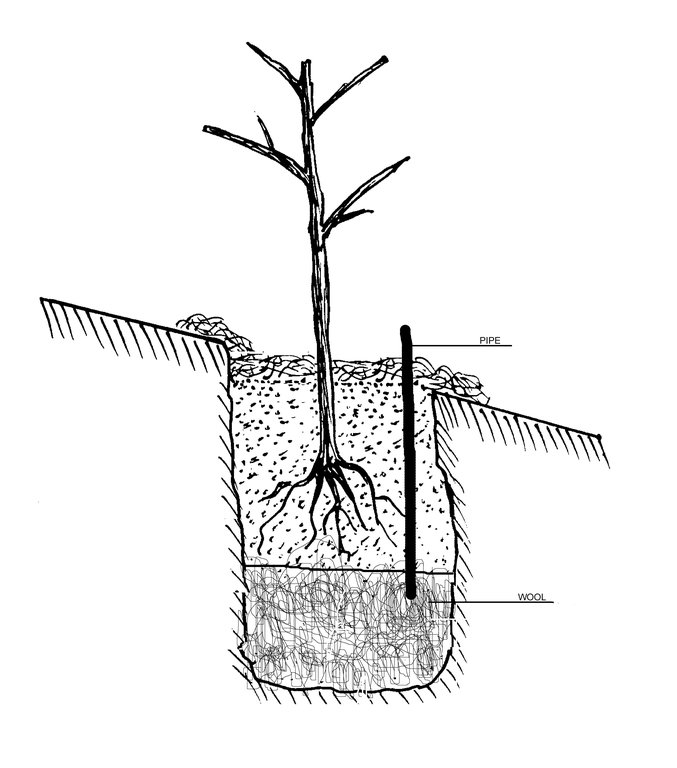A woollen water retention bed installed under the roots of a tree irrigated by a pipe feed. [Tajikistan]
- Creation:
- Update:
- Compiler: Sa'dy Odinashoev
- Editor: –
- Reviewers: David Streiff, Alexandra Gavilano
technologies_1508 - Tajikistan
- Full summary as PDF
- Full summary as PDF for print
- Full summary in the browser
- Full summary (unformatted)
- A woollen water retention bed installed under the roots of a tree irrigated by a pipe feed.: March 21, 2017 (inactive)
- A woollen water retention bed installed under the roots of a tree irrigated by a pipe feed.: July 28, 2017 (inactive)
- A woollen water retention bed installed under the roots of a tree irrigated by a pipe feed.: Nov. 2, 2021 (public)
View sections
Expand all Collapse all1. General information
1.2 Contact details of resource persons and institutions involved in the assessment and documentation of the Technology
land user:
Esanov Ahmad
Tajikistan
1.3 Conditions regarding the use of data documented through WOCAT
When were the data compiled (in the field)?
18/05/2011
The compiler and key resource person(s) accept the conditions regarding the use of data documented through WOCAT:
Yes
2. Description of the SLM Technology
2.1 Short description of the Technology
Definition of the Technology:
The use of sheep's wool placed below the roots of fruit trees, to retain the water fed from a surface pipe.
2.2 Detailed description of the Technology
Description:
A bed of wool is placed within the hole before a fruit sapling is planted. The wool is fed water via a plastic pipe, which is used to saturate the wool with irrigated water. This provides a prolonged source of moisture for the trees which subsequently helps the tree survive intense dry periods and improves fruit yields.
This technology could also be applied using hay or pressed sawdust as an alternative to the wool to store the water.
Purpose of the Technology: The purpose was to implement a sustainable cost effective and easy irrigation process that will help increase fruit production in the Pejikant region of Tajikistan during the long hot dry summer periods. The process utilises readily locally available natural materials that are environmentally friendly.
Establishment / maintenance activities and inputs: A 1m deep hole is prepared to plant the tree inside. Placed at the foot of the hole is layer of natural wool, approximately 10kg, and a plastic pipe is installed running from the wool layer to the above the surface. On top of the wool a bed of organic compost and/or high quality soil is placed to assist the growth and the sapling is planted in this. The sapling is then watered through the pipe. It is estimated that 10kg of wool will retain around 8 litres of water.
Natural / human environment: This region has low levels of annual precipitation and poor soil quality. Therefore, the land users are reliant on devising ways to improve the soil quality and irrigation practices to increase the amount of land that can be cultivated. With an increasing population and a heavy relaince on the land to support the people, there is a strong desire to bring into production land that in its current state is unproductive.
2.3 Photos of the Technology
2.5 Country/ region/ locations where the Technology has been applied and which are covered by this assessment
Country:
Tajikistan
Region/ State/ Province:
Tajikistan, Sughd
Further specification of location:
Penjakent, Toshmunor
Map
×2.6 Date of implementation
If precise year is not known, indicate approximate date:
- less than 10 years ago (recently)
2.7 Introduction of the Technology
Specify how the Technology was introduced:
- through land users' innovation
Comments (type of project, etc.):
The land users developed this technology.
3. Classification of the SLM Technology
3.1 Main purpose(s) of the Technology
- improve production
3.2 Current land use type(s) where the Technology is applied

Cropland
- Tree and shrub cropping

Forest/ woodlands
Tree plantation, afforestation:
- Mixed varieties
Products and services:
- Fruits and nuts
Comments:
Major land use problems (compiler’s opinion): The soil structure is very poor, with low density vegetation cover.
Major land use problems (land users’ perception): There is a lack of irrigation water for the vegetation.
Plantation forestry: Fruit orchards
Forest products and services: fruits and nuts
3.3 Further information about land use
Number of growing seasons per year:
- 2
Specify:
Longest growing period in days: 270Longest growing period from month to month: October-JuneSecond longest growing period in days: 90Second longest growing period from month to month: July-Septeber
3.4 SLM group to which the Technology belongs
- irrigation management (incl. water supply, drainage)
3.5 Spread of the Technology
Specify the spread of the Technology:
- evenly spread over an area
If the Technology is evenly spread over an area, indicate approximate area covered:
- < 0.1 km2 (10 ha)
3.6 SLM measures comprising the Technology

agronomic measures
- A2: Organic matter/ soil fertility

vegetative measures
- V1: Tree and shrub cover
Comments:
Main measures: structural measures
3.7 Main types of land degradation addressed by the Technology

soil erosion by water
- Wt: loss of topsoil/ surface erosion

soil erosion by wind
- Et: loss of topsoil

biological degradation
- Bc: reduction of vegetation cover
- Bq: quantity/ biomass decline

water degradation
- Ha: aridification
Comments:
Main type of degradation addressed: Wt: loss of topsoil / surface erosion, Bc: reduction of vegetation cover
Secondary types of degradation addressed: Et: loss of topsoil, Bq: quantity / biomass decline, Ha: aridification
Main causes of degradation: overgrazing (Increasing numbers of livestock), other human induced causes (specify) (Disintegration of the irrigation system), change in temperature, war and conflicts (After the collapse of Sovet Union the irrigation pipes were stolen)
Secondary causes of degradation: change of seasonal rainfall, droughts
3.8 Prevention, reduction, or restoration of land degradation
Specify the goal of the Technology with regard to land degradation:
- reduce land degradation
- restore/ rehabilitate severely degraded land
4. Technical specifications, implementation activities, inputs, and costs
4.1 Technical drawing of the Technology
4.2 Technical specifications/ explanations of technical drawing
The photo shows how the tree will be planted; 1) digging of hole, 2) inlaying the wool, 3) installing the pipe, 4) planting the tree.
Location: Toshminor. Penjakent, Sughd, Tajikistan
Date: 2011-05-18
Technical knowledge required for land users: low (It is easy to replicate.)
Main technical functions: increase of infiltration, water harvesting / increase water supply
Secondary technical functions: improvement of ground cover, improvement of subsoil structure (hardpan)
Structural measure: placement of wool
Depth of ditches/pits/dams (m): 1
Width of ditches/pits/dams (m): 1
Construction material (other): 10kg of wool inserted per tree.
4.3 General information regarding the calculation of inputs and costs
other/ national currency (specify):
Somoni
Indicate exchange rate from USD to local currency (if relevant): 1 USD =:
4.7
4.4 Establishment activities
| Activity | Type of measure | Timing | |
|---|---|---|---|
| 1. | A 1m deep hole is prepared to plant the tree inside. | Structural | spring |
| 2. | Placing approximately 10kg of wool at the foot of the hole | Structural | spring |
| 3. | installing of plastic pipe from the wool layer to the above surface | Structural | spring |
| 4. | On top of the wool a bed of organic compost and/or high quality soil is placed to assist the growth | Structural | spring |
4.5 Costs and inputs needed for establishment
| Specify input | Unit | Quantity | Costs per Unit | Total costs per input | % of costs borne by land users | |
|---|---|---|---|---|---|---|
| Labour | Digging hole | Persons/day | 0.1 | 20.0 | 2.0 | 100.0 |
| Construction material | Plastic pipe | meter | 1.0 | 4.0 | 4.0 | 100.0 |
| Total costs for establishment of the Technology | 6.0 | |||||
4.7 Costs and inputs needed for maintenance/ recurrent activities (per year)
Comments:
The costs previously are based on the cost for providing enough pipe for one tree.
4.8 Most important factors affecting the costs
Describe the most determinate factors affecting the costs:
In this situation, the wool is free to the farmers as they obtain it from their own sheep.
The labour is provided free of charge by the farmers themselves.
5. Natural and human environment
5.1 Climate
Annual rainfall
- < 250 mm
- 251-500 mm
- 501-750 mm
- 751-1,000 mm
- 1,001-1,500 mm
- 1,501-2,000 mm
- 2,001-3,000 mm
- 3,001-4,000 mm
- > 4,000 mm
Agro-climatic zone
- semi-arid
Thermal climate class: temperate
5.2 Topography
Slopes on average:
- flat (0-2%)
- gentle (3-5%)
- moderate (6-10%)
- rolling (11-15%)
- hilly (16-30%)
- steep (31-60%)
- very steep (>60%)
Landforms:
- plateau/plains
- ridges
- mountain slopes
- hill slopes
- footslopes
- valley floors
Altitudinal zone:
- 0-100 m a.s.l.
- 101-500 m a.s.l.
- 501-1,000 m a.s.l.
- 1,001-1,500 m a.s.l.
- 1,501-2,000 m a.s.l.
- 2,001-2,500 m a.s.l.
- 2,501-3,000 m a.s.l.
- 3,001-4,000 m a.s.l.
- > 4,000 m a.s.l.
Comments and further specifications on topography:
Slopes on average: Also hilly
5.3 Soils
Soil depth on average:
- very shallow (0-20 cm)
- shallow (21-50 cm)
- moderately deep (51-80 cm)
- deep (81-120 cm)
- very deep (> 120 cm)
Soil texture (topsoil):
- coarse/ light (sandy)
Topsoil organic matter:
- low (<1%)
If available, attach full soil description or specify the available information, e.g. soil type, soil PH/ acidity, Cation Exchange Capacity, nitrogen, salinity etc.
Soil fertility is very low
Soil drainage / infiltration is good
Soil water storage capacity is low
5.4 Water availability and quality
Ground water table:
> 50 m
Availability of surface water:
poor/ none
Water quality (untreated):
good drinking water
5.5 Biodiversity
Species diversity:
- low
5.6 Characteristics of land users applying the Technology
Market orientation of production system:
- subsistence (self-supply)
Off-farm income:
- > 50% of all income
Relative level of wealth:
- poor
Individuals or groups:
- individual/ household
Gender:
- men
Indicate other relevant characteristics of the land users:
Land users applying the Technology are mainly common / average land users
Population density: 10-50 persons/km2
Annual population growth: 2% - 3%
100% of the land users are poor.
Market orientation of production system: Self consumption of fruits
5.7 Average area of land owned or leased by land users applying the Technology
- < 0.5 ha
- 0.5-1 ha
- 1-2 ha
- 2-5 ha
- 5-15 ha
- 15-50 ha
- 50-100 ha
- 100-500 ha
- 500-1,000 ha
- 1,000-10,000 ha
- > 10,000 ha
Is this considered small-, medium- or large-scale (referring to local context)?
- small-scale
5.8 Land ownership, land use rights, and water use rights
Land ownership:
- state
Land use rights:
- leased
Water use rights:
- leased
5.9 Access to services and infrastructure
health:
- poor
- moderate
- good
education:
- poor
- moderate
- good
technical assistance:
- poor
- moderate
- good
employment (e.g. off-farm):
- poor
- moderate
- good
markets:
- poor
- moderate
- good
energy:
- poor
- moderate
- good
roads and transport:
- poor
- moderate
- good
drinking water and sanitation:
- poor
- moderate
- good
financial services:
- poor
- moderate
- good
6. Impacts and concluding statements
6.1 On-site impacts the Technology has shown
Socio-economic impacts
Production
crop production
wood production
risk of production failure
production area
Water availability and quality
drinking water availability
Income and costs
farm income
workload
Socio-cultural impacts
food security/ self-sufficiency
health situation
SLM/ land degradation knowledge
Livelihood and human well-being
Comments/ specify:
It has helped improve the fruit harvests on land that was becoming increasingly degraded and would in the future be unsuitable for farming practices.
Ecological impacts
Water cycle/ runoff
harvesting/ collection of water
surface runoff
evaporation
Soil
soil moisture
soil cover
6.3 Exposure and sensitivity of the Technology to gradual climate change and climate-related extremes/ disasters (as perceived by land users)
Gradual climate change
Gradual climate change
| Season | Type of climatic change/ extreme | How does the Technology cope with it? | |
|---|---|---|---|
| annual temperature | increase | well |
Climate-related extremes (disasters)
Meteorological disasters
| How does the Technology cope with it? | |
|---|---|
| local rainstorm | well |
| local windstorm | well |
Climatological disasters
| How does the Technology cope with it? | |
|---|---|
| drought | well |
6.4 Cost-benefit analysis
How do the benefits compare with the establishment costs (from land users’ perspective)?
Short-term returns:
neutral/ balanced
Long-term returns:
positive
How do the benefits compare with the maintenance/ recurrent costs (from land users' perspective)?
Short-term returns:
neutral/ balanced
Long-term returns:
very positive
Comments:
The impacts can be seen within the first growing season.
6.5 Adoption of the Technology
If available, quantify (no. of households and/ or area covered):
NA
Comments:
There is a little trend towards spontaneous adoption of the Technology
Comments on adoption trend: Some other people and projects expressed an interest.
6.7 Strengths/ advantages/ opportunities of the Technology
| Strengths/ advantages/ opportunities in the land user’s view |
|---|
| It improves the fruit harvest. |
|
It is easy to buy the wool. How can they be sustained / enhanced? Wool could be made available to other orchards. |
| It is cheap and easy to implement. |
| Strengths/ advantages/ opportunities in the compiler’s or other key resource person’s view |
|---|
|
It reduces the number of times the trees need to be irrigated. How can they be sustained / enhanced? The technology is so easy to implement, the information should be dispersed to other farmers. |
| It improves the soil moisture content of the orchards. |
|
The technology could be applied in very dry, desert conditions How can they be sustained / enhanced? It could be used in the more dry arid areas of the country. |
|
It increases the length of the planting season, as it holds the water in the ground for longer. How can they be sustained / enhanced? To implement the technology across a wider area. |
|
It can be applied to older, established trees, not just seedlings. How can they be sustained / enhanced? Educate the farmers about these methods. |
6.8 Weaknesses/ disadvantages/ risks of the Technology and ways of overcoming them
| Weaknesses/ disadvantages/ risks in the compiler’s or other key resource person’s view | How can they be overcome? |
|---|---|
| It still reliant on some water being available at crucial times of the year. | Piped irrigation to the land plot |
Links and modules
Expand all Collapse allLinks
No links
Modules
No modules


